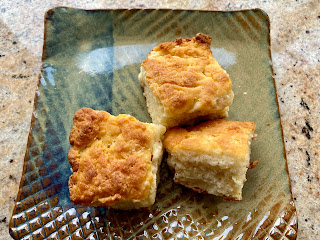
I ask my wife to take over.
Ingredients
3 1/2 ounces good-quality, mild blue cheese (we used Cambozola cheese)
3 tablespoons unsalted butter, at room temperature
1/2 cup flour
1/4 cup cornstarch
1/4 teaspoon coarse salt
1/8 teaspoon freshly ground black pepper (we used cayenne pepper)
1/3 cup walnuts, finely chopped
Directions
Preheat the oven to 325 degrees. Line a baking sheet with parchment paper. Combine the flour, cornstarch, salt and pepper in a bowl and set aside.Combine the blue cheese and butter in the bowl of a food processor; pulse until thoroughly blended. We also added the walnuts to the mixture in the food processor and pulsed until they were cut up too. According to the instructions at this point we were to add the flour, cornstarch, salt and pepper into the cheese mixture and mix until a moist dough was formed. Since the food processor we were using was pretty small, we transferred the contents of the food processor to the bowl of dry ingredients to make the dough. Gather up the dough into a flat disk. Roll out the dough to a thickness of 1/4 inch. Use 2-inch cookie cutters to cut out shapes (We just cut the dough into 1 inch squares using a knife).
Transfer to the baking sheet, spacing the cookies 1 inch apart. Bake for 12 to 14 minutes until lightly golden on the edges. Transfer to a wire rack to cool completely before serving or storing.
As I mentioned earlier blue cheese cooking in the oven is not a pleasant smell. We were a little afraid of what the cookie would taste like after smelling it cook. (Not only did it smell bad but the smell permeated the entire house). Luckily the cookie tastes much better than it smelled. Initially the cheese taste was s bit strong but over time it mellowed into a tangy flavor that went very well with the included walnuts and above all goes well with the red wine we were having.
















